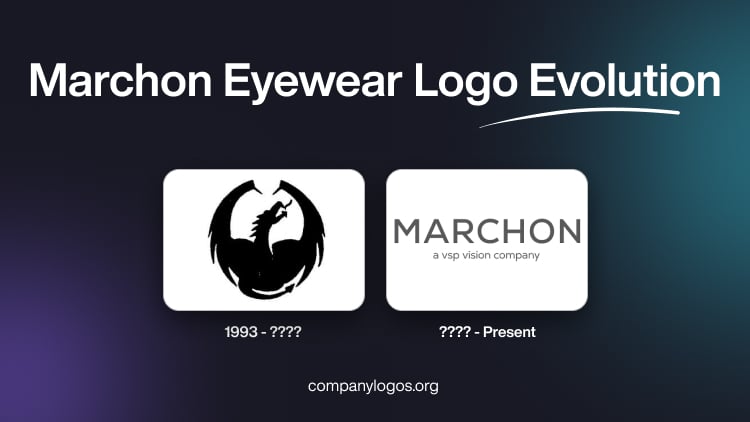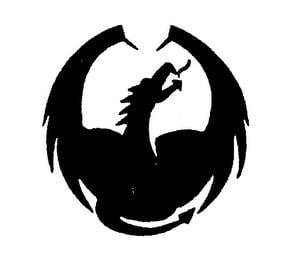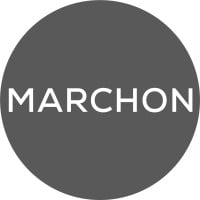
Marchon Eyewear is one of the most influential names in the global eyewear industry. The company has partnerships with luxury fashion brands, such as Calvin Klein, Converse, Columbia, Flexon, Skaga, Nike, Zeiss, Lacoste, Victoria Beckham, Karl Lagerfeld, Longchamp, and many others.
Although the logo and brand identity of Marchon Eyewear are not well documented, they reflect the four-decade journey from a small startup to an international powerhouse with strategic partnerships with some of the world’s most prestigious fashion brands. The article delves into the evolution of the Marchon Eyewear logo over the years, among other details.
The Genesis of the Marchon Eyewear Logo (1983 – 1993) (Unavailable)
The original logo of Marchon Eyewear is not available. However, it is assumed that it represented the company’s founding vision of creating high-quality, fashionable eyewear at affordable prices.
(1993 – ????)
One of the earliest logos designed by Marchon Eyewear was that of a dragon or griffon in monochrome, a mythological creature. This was submitted for registration with the US trademark on April 1, 1993.

(???? – Present)
The current Marchon Eyewear logo sports the big-sized brand name “MARCHON” in a clean, modern, uppercase sans-serif typeface and the tagline “a vsp vision company” in grey lowercase, but in a much smaller size.

Alongside the logotype exists a circular emblem with a grey background and white text depicting “MARCHON”.

The Elements of the Marchon Eyewear Logo
Font
The Marchon Eyewear logo employs a neutral, clean, modern, and uppercase sans-serif typeface. The typeface conveys the commitment of the company to innovation and contemporary design. Besides, the typographical choice of sans-serif aligns with industry standards for eyewear brands. This is due to the fact that the typeface with consistent proportions of its letterforms provides excellent readability across platforms.
Colour
The Marchon Eyewear logo uses a grey/charcoal colour against light backgrounds. The colour conveys reliability, sophistication, and professional competence. This is of utmost importance as Marchon Eyewear partners with luxury brands such as Calvin Klein, Victoria Beckham, and Salvatore Ferragamo.
The History of Marchon Eyewear
Marchon Eyewear was established in 1983 by three visionary entrepreneurs: Al Berg, Larry Roth, and Jeff White. The company began operations in Plainview, New York, with a modest team of 12 employees and 12 agents. Al Berg, who was an eyewear industry veteran and had previously worked for established companies such as Bausch & Lomb and American Optical, brought valuable experience to the venture.
Berg’s vision was ambitious yet clear. He wanted to create a company that would produce high-quality, fashionable eyewear at affordable prices. Despite the seemingly unrealistic goal of becoming major players in an area completely dominated by international suppliers, the founders were confident that there were all the prerequisites for a US-based eyewear company to become a key player on the world scene.
The early years of the company were marked by rapid development and strategic positioning within the American eyewear market. The combined expertise of the founders created a strong foundation for growth. It was further facilitated by Berg’s marketing creativity and deal-making skills, White’s technological innovation focus, and Roth’s operational expertise.
During these formative years, Marchon focused on developing its proprietary technology for making eyewear. This set the stage for the revolutionary innovations that would follow. The company’s commitment to quality and innovation quickly paid off. It created the groundwork for what would become one of the most significant technological breakthroughs in the history of eyewear.
The year 1988 marked a transformation in Marchon’s history with two significant developments. First, operations were transferred from the small office in Plainview to a leading-edge facility in Melville, New York.
More importantly, 1988 witnessed the launch of Marchon’s revolutionary Flexon memory metal eyewear collection with the Autoflex line. This groundbreaking innovation utilised a titanium-nickel alloy originally discovered by U.S. Naval scientists in 1961 for use in missile heat shields. The material possessed an extraordinary property: it could be bent, twisted, or even hit with a hammer, yet would return to its original shape when exposed to heat.
The instant success of the Flexon collection allowed for further research and development. This led to Marchon developing products made from Flexon Memory Metal in every conceivable style and design. The innovation revolutionised the eyewear industry and created an entirely new material category for eyeglass frames. With over 19 years of manufacturing experience by 2007, Flexon products became the choice for over 20 million satisfied wearers.
The early 1990s marked Marchon’s strategic shift toward luxury designer partnerships, which began with Calvin Klein in 1992. This partnership represented one of the first major designer licensing deals in the eyewear industry and marked the beginning of a relationship that would span over 30 years.
International expansion began in 1992 with the opening of Marchon’s first international office in Milan, Italy. This was followed by offices in Hong Kong and Tokyo in subsequent years. By 1996, Marchon had established Marchon Eyewear (Hong Kong) Ltd to serve major markets including Japan, Korea, Mainland China, North America, Southeast Asia, Taiwan, and Western Europe.
During this period, Marchon secured prestigious licensing agreements with numerous high-profile brands. These include Calvin Klein, Disney, Fendi, Nautica, Nike, and X Games and later expanded to include Coach and Michael Kors. This strategic approach of partnering with established fashion and lifestyle brands became a cornerstone of Marchon’s business model.
The company grew rapidly from its humble beginnings with 12 employees in 1983 to over 2,500 employees worldwide by its 25th anniversary in 2008. The company established offices and distribution centres in over 30 countries worldwide during this period.
A transformative moment in Marchon’s history occurred on August 18, 2008, when Vision Service Plan (VSP) acquired the company for $735 million in a transaction funded by a combination of cash and debt. The acquisition created a combined entity with projected revenues of $3.3 billion.
Under the acquisition agreement, Marchon became a wholly owned subsidiary of VSP while maintaining its independence and leadership structure. Al Berg continued as Marchon’s CEO, and Larry Roth remained as executive vice president. The company maintained its Melville, New York, headquarters as an independent entity within the VSP organisation.
One of the strategic considerations in the acquisition was the synergy between Marchon’s OfficeMate Software Solutions and VSP’s Eyefinity web-based business management platform. The merger of these systems created a comprehensive “eyecare business solutions organisation” that provided integrated practice management and electronic medical records software to the optical industry.
After the VSP acquisition, Marchon continued its expansion strategy through strategic acquisitions and brand partnerships. In 2012, the company acquired Scandinavian Eyewear, a Swedish company established in 1948 that had been designing optical frames for almost 65 years. The acquisition included the well-established SKAGA brand, which had made a distinctive mark in the Nordic region.
Scandinavian Eyewear brought a rich portfolio of brands, including Oscar Jacobson, Pilgrim, Lexington, and FACE Stockholm, as well as collaborations with renowned Swedish designers Oscar Magnuson and Efva Attling. The acquisition enabled Marchon to leverage the company’s considerable presence in the Scandinavian market while expanding global distribution of both proprietary and licensed brands.
The company continued to expand its brand portfolio with high-profile licensing agreements. In 2015, Marchon announced an exclusive global licensing agreement with luxury brand MCM (Modern Creation München), which brought the iconic German luxury brand into its eyewear portfolio. The MCM eyewear collection featured distinctive logo plaques inspired by the gold brass plates that identify original MCM handbags.
The 2020s have been marked by Marchon’s evolution into a sustainability-focused industry leader. In 2020, the company signed a global licensing agreement with Converse, which added the iconic footwear brand to its expanding portfolio. The Converse eyewear collection incorporates recognisable design elements such as the ‘All Star’ patch and ‘Star Chevron’ logo.
A defining moment came in 2023 when Marchon celebrated its 40th anniversary by launching the “EYES ON TOMORROW” Corporate Social Responsibility platform. This comprehensive sustainability initiative is built on three pillars: eyewear, supply chain, and people. The programme guides the company in ensuring that its eyewear and processes have a reduced impact on the planet.
The sustainability commitment includes ambitious goals for material usage. In 2022, Marchon produced 25% of its frames from recycled and bio-based materials. By 2023, the company was on track to hit 35% sustainable materials, with President Thomas Burkhardt setting a goal of making at least 50% of frames with sustainable materials by 2025.
Marchon has expanded its use of eco-friendly materials, including Eastman Acetate Renew, sustainable acetate, recycled plastic, and plant-based resin. The company has also introduced recycled stainless steel into its material portfolio, which started with collections from JOE by Joseph Abboud under Altair.
The company experienced significant leadership changes with the passing of co-founder Al Berg in March 2019 after a two-year battle with cancer. Berg, who was 67 at the time of his death, had been a pre-eminent figure in the optical industry and continued his role at Marchon for about a year after the VSP acquisition.
Marchon operates as part of VSP Vision’s enterprise division and serves VSP Vision’s partners across the country in an efficient manner. The company has maintained its position among the world’s five largest global eyewear players by selling 22 million units annually.
Marchon’s current brand portfolio includes over 30 prestigious names. These represent some of the most recognisable brands in fashion, sports, and lifestyle segments. The licensed brands include Calvin Klein, Nike, Lacoste, Salvatore Ferragamo, Victoria Beckham, Karl Lagerfeld, Longchamp, Converse, Columbia, and many others.
In recent years, Marchon has received significant industry recognition for its innovation and sustainability efforts. In 2023, the company won MIDO’s “Stand Up For Green” award for its sustainable booth design. In 2024, Marchon received multiple design awards, including the Accessories Council Design Excellence Award and the MIDO CSE (Certified Sustainable Eyewear) Award.
Marchon has established meaningful partnerships that extend beyond business operations. The company has renewed its global partnership with Plastic Bank, which focuses on environmental and social impact. Through this collaboration, customers who choose Nautica or Columbia eyewear help support Marchon’s annual commitment to prevent at least 45,455 kg of plastic from polluting the environment.
The partnership supports the collection of plastic waste from vulnerable coastal areas, particularly in Brazil, while improving the lives of community members involved in the collection process. This initiative demonstrates Marchon’s commitment to creating positive environmental, social, and economic impact through its business operations.
The company’s four-decade journey reflects remarkable resilience, innovation, and adaptation to changing market conditions. Over the years, Marchon has consistently pushed the boundaries of what’s possible in the eyewear industry while maintaining its commitment to quality, innovation, and global partnerships.
Interesting Facts About Marchon Eyewear
- Marchon Eyewear was established in Melville, New York, and it quickly grew into one of the largest eyewear companies in the world.
- Since 2008, Marchon has been a subsidiary of VSP Vision (formerly VSP Global), which links it to one of the largest vision care providers in the world.
- Marchon distributes eyewear to thousands of optical retailers, department stores, and duty-free shops across more than 100 countries.
- It produces and distributes eyewear for major fashion and lifestyle brands. These include Calvin Klein, Nike Vision, Lacoste, Salvatore Ferragamo, Karl Lagerfeld, and Longchamp, among others.
- Marchon also owns Altair Eyewear, a division that distributes brands like Genesis, Sunlites, and Aspire Eyewear, mainly in the U.S. market.
- The company has been a pioneer in developing lightweight, flexible materials for eyewear, which make frames more comfortable and durable.
- In recent years, Marchon has launched eco-friendly eyewear collections and packaging.
- Marchon has invested in advanced lens and frame technologies, such as memory metals and flexible hinges, to improve fit and durability.
- The company has design studios in New York, Italy, and Japan. It thus blends American creativity with European luxury styling and Japanese precision.
- Thanks to its luxury fashion collaborations, Marchon eyewear brands often appear on international runways and in top fashion magazines.
- Through its parent company VSP Vision, Marchon is tied to an employee-governed not-for-profit structure, which makes it unusual in the fashion and eyewear industry.
- Marchon is a regular exhibitor at major global optical and fashion trade shows such as Vision Expo (U.S.) and MIDO (Milan), where it showcases new collections to retailers and designers.
Finally
The evolution of the logo of Marchon Eyewear represents a masterful balance of innovation, tradition, and strategic partnership management. The details of the company’s logo evolution are sketchy, and most could not be retraced. However, the Marchon logo represents more than four decades of eyewear excellence. It embodies the company’s mission to “help people around the world see” while looking forward to a sustainable future in eyewear design and manufacturing.